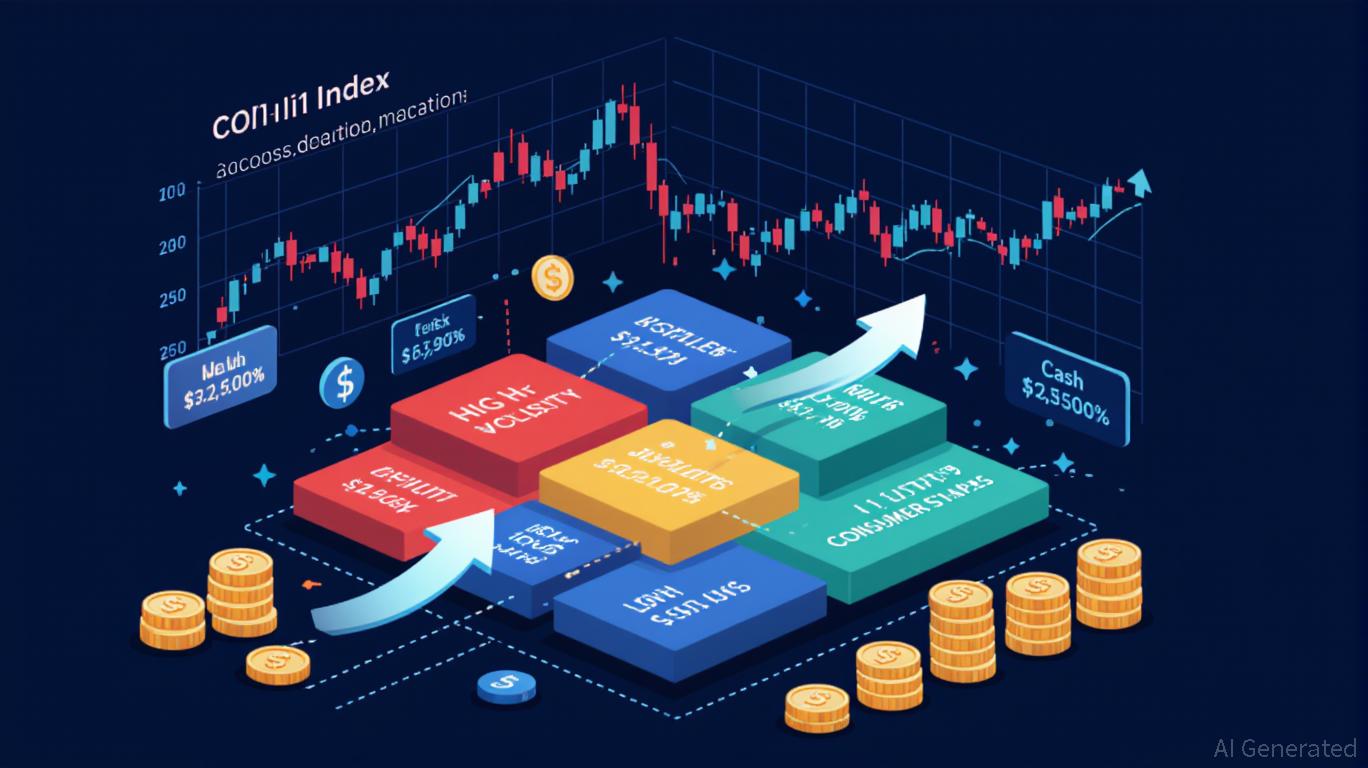The Unexpected COAI Price Decline: Key Lessons for Investors from the November 2025 Market Turbulence
- COAI Index's 88% November 2025 collapse stemmed from C3.ai governance failures, regulatory ambiguity, and panic-driven herd behavior. - Market psychology amplified losses as investors overreacted to AI sector risks, ignoring fundamentals and triggering liquidity crises. - Diversification, cash reserves, and AI-driven tools helped mitigate risks, emphasizing long-term strategies over speculative hype. - The crisis exposed dangers of overreliance on AI/DeFi narratives, urging disciplined, diversified portf
The COAI Index Crash: A Case Study in Market Fragility
In November 2025, the COAI Index experienced a dramatic decline, plummeting by 88% within a matter of weeks. This event starkly illustrated how quickly confidence can evaporate in speculative markets. The collapse was not just a routine correction; it was a systemic failure fueled by lapses in corporate governance, unclear regulatory guidance, and a wave of emotionally charged decisions by investors. This episode highlights the importance for investors to recognize the psychological dynamics at play during market upheavals and to employ disciplined, diversified approaches to safeguard their portfolios.
Key Triggers: Leadership Failures and Regulatory Confusion
The downfall of the COAI Index was set in motion by turmoil at C3.ai, a pivotal player in the AI and DeFi landscape. By early 2025, the company was already under pressure, having reported a $116.8 million deficit, undergone a contentious change in leadership, and faced a class-action lawsuit over alleged mismanagement. These issues severely undermined confidence in the company and, by extension, cast doubt on the broader promise of AI-powered crypto ventures. The situation was further complicated by the introduction of the CLARITY Act—a regulatory initiative intended to bring oversight to AI technologies. Instead of providing clarity, however, it left investors uncertain about compliance and potential liabilities, deepening the sense of instability.
Investor Behavior: Panic, Herd Mentality, and Biases
The crash of the COAI Index was as much about psychology as it was about economics. After months of volatility, investors responded with panic-driven selling, heavily influenced by herd behavior and cognitive distortions. According to a Bitget report, the market panic in April 2025, which was sparked by similar concerns in the AI sector, revealed that many investors fell prey to "recency bias"—overestimating the likelihood of ongoing gains while ignoring mounting risks. Social and traditional media amplified these anxieties, fueling a cycle of fear and further sell-offs. Deutsche Bank's AI-powered dbLumina system demonstrated that, during downturns, human investors often act irrationally, locking in losses and missing out on eventual recoveries.
This emotional response was evident as COAI investors continued to exit the market, even as the S&P 500 rebounded by 23% after the April 2025 low. Many mistook isolated corporate setbacks for systemic threats, triggering a liquidity crunch that intensified the decline.
Protective Measures: The Role of Diversification and Discipline

The COAI Index collapse underscored the necessity of robust risk management. Defensive tactics—such as shifting investments into traditionally stable sectors like utilities and consumer staples—became increasingly popular as investors sought to shield their capital. Fixed-income assets and cash holdings also served as important buffers against the volatility of the AI sector. Research from GetCOAI in 2025 found that maintaining a cash allocation of 20-30% enabled investors to seize opportunities in undervalued assets during the downturn.
For those with exposure to AI and DeFi, spreading investments across different regions and industries proved vital. Value and small-cap stocks, which often outperform during corrections in growth sectors, helped balance portfolios. Additionally, using options and derivatives—such as purchasing put options on broad market indices—offered protection against losses without sacrificing the potential for gains.
Long-Term Strategy: Steering Clear of Speculative Traps
The COAI Index crash also revealed the risks of chasing speculative trends. Many younger investors were drawn in by the promise of an "AI revolution," often at the expense of sound fundamentals. Those who maintained a long-term perspective and diversified their holdings weathered the storm more effectively. As highlighted by Investment News, investors who stuck to a balanced 60/40 mix of equities and fixed income experienced minimal capital loss during the crisis.
Importantly, the turmoil demonstrated the value of AI-based analytical tools in counteracting emotional decision-making. Systems like dbLumina, which assess market trends without human bias, provided more objective guidance during the downturn. This suggests that individual investors could benefit from incorporating algorithmic analysis into their investment strategies to help avoid panic-driven mistakes.
Takeaways: Building Resilience for Future Shocks
The events surrounding the COAI Index in November 2025 serve as a powerful lesson on the interconnected roles of governance, regulation, and investor psychology. While volatility is an inherent feature of speculative sectors like AI and DeFi, the scale of the collapse was magnified by herd behavior and insufficient risk management. The key message for investors is clear: diversify across sectors and asset types, maintain adequate liquidity, and focus on long-term fundamentals rather than short-lived trends. In a world where market disruptions are becoming more common, maintaining discipline and strategic foresight is essential for enduring success.
Disclaimer: The content of this article solely reflects the author's opinion and does not represent the platform in any capacity. This article is not intended to serve as a reference for making investment decisions.
You may also like
Solar radiation reveals previously undetected software flaw in Airbus aircraft fleet
- Airbus issues emergency directive to update A320 fleet software/hardware after solar radiation-linked flight-control incident caused JetBlue's emergency landing. - EU Aviation Safety Agency mandates fixes for 6,000 aircraft, risking Thanksgiving travel chaos as airlines face weeks-long groundings for repairs. - Solar interference vulnerability, previously flagged by FAA in 2018, highlights growing software reliability challenges in modern avionics systems. - Analysts call issue "manageable" but warn of s

Khabib's NFTs Ignite Discussion: Honoring Culture or Taking Advantage?
- Khabib Nurmagomedov's $4.4M NFT collection, rooted in Dagestani heritage, sparked controversy over cultural symbolism and legacy claims. - The project sold 29,000 tokens rapidly but faced scrutiny for post-launch transparency gaps and parallels to failed celebrity NFT ventures. - NFT market recovery (2025 cap: $3.3B) highlights risks like "rug pulls" and volatility, despite celebrity-driven momentum. - Concurrent trends include crowdfunding innovations and sustainability-focused markets like OCC recyclin

Ethereum Updates Today: Fusaka Upgrade on Ethereum Triggers Structural Deflation Through L2 Collaboration
- Ethereum's Fusaka upgrade (Dec 3, 2025) introduces EIP-7918, linking L2 data costs to mainnet gas prices, boosting ETH burn rates and accelerating deflationary trajectory. - PeerDAS and BPO forks reduce validator demands while enabling scalable 100k TPS growth through modular upgrades, avoiding disruptive hard forks. - Analysts predict 40-60% lower L2 fees for DeFi/gaming, with institutional ETH accumulation and a 5% price rebound signaling confidence in post-upgrade value capture. - The upgrade creates

Bitcoin News Update: Stablecoin Growth Drives Cathie Wood's Updated Bullish Outlook on Bitcoin, Not Market Weakness
- ARK's Cathie Wood maintains $1.5M Bitcoin long-term target despite 30% price drop, adjusting 2030 forecast to $1.2M due to stablecoin competition. - She attributes market volatility to macroeconomic pressures, not crypto fundamentals, and highlights Bitcoin's historical liquidity-driven rebounds. - UK's "no gain, no loss" DeFi tax framework and firms like Hyperscale Data ($70.5M BTC treasury) reflect evolving regulatory and strategic dynamics. - Bitfarms' exit from Bitcoin mining to AI HPC by 2027 unders
